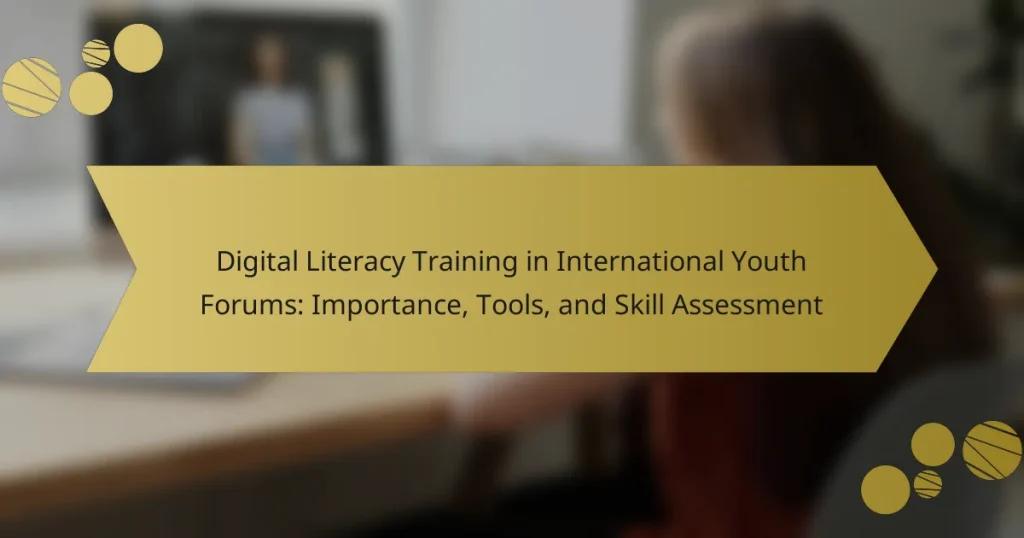Digital Literacy Training in International Youth Forums is a program aimed at enhancing young people’s proficiency in using digital technology effectively. The training covers key areas such as information evaluation, online communication, and digital content creation, while also emphasizing critical thinking and problem-solving skills. Participants engage in workshops and collaborative projects, fostering a supportive learning environment that accommodates diverse backgrounds. Assessment of digital literacy is conducted through surveys, interactive workshops, and practical demonstrations, focusing on problem-solving and effective communication. The article outlines the importance of these training programs, the tools used, and the methods for skill assessment to improve youth engagement in global discussions and prepare them for the modern workforce.

What is Digital Literacy Training in International Youth Forums?
Digital Literacy Training in International Youth Forums is a program designed to enhance young people’s skills in using digital technology effectively. This training focuses on various aspects of digital literacy, including information evaluation, online communication, and digital content creation. Participants learn to navigate digital platforms safely and responsibly. The training also emphasizes critical thinking and problem-solving in digital contexts. Evidence shows that such training increases youth engagement in global discussions. It equips them with essential skills for the modern workforce. Programs often include workshops, interactive sessions, and collaborative projects. This approach fosters a supportive learning environment for youth from diverse backgrounds.
Why is Digital Literacy Training important for youth in international forums?
Digital literacy training is crucial for youth in international forums because it equips them with essential skills for effective participation. These skills include critical thinking, information evaluation, and digital communication. In a globalized world, youth must navigate diverse digital platforms and engage with various cultures. Training enhances their ability to collaborate on international issues, fostering a sense of global citizenship. Furthermore, research indicates that digital literacy can lead to increased employability and career opportunities. According to a report by the International Telecommunication Union, 90% of jobs require some level of digital skills. Thus, digital literacy training empowers youth to contribute meaningfully in international discussions and initiatives.
How does digital literacy impact youth engagement in global discussions?
Digital literacy significantly enhances youth engagement in global discussions. It equips young individuals with the skills to access, analyze, and communicate information effectively. This capability fosters informed participation in diverse dialogues. Research shows that digitally literate youth are more likely to engage in online forums and social media discussions. A study by the Pew Research Center found that 88% of teens use social media for civic engagement. This demonstrates the direct correlation between digital skills and active participation. Furthermore, digital literacy promotes critical thinking, allowing youth to evaluate sources and construct well-informed arguments. Thus, digital literacy serves as a crucial foundation for meaningful youth involvement in global conversations.
What role does digital literacy play in fostering collaboration among youth?
Digital literacy plays a crucial role in fostering collaboration among youth. It equips them with the skills needed to communicate effectively in digital environments. These skills include using collaborative tools like Google Docs and Slack. Digital literacy enhances their ability to share ideas and resources seamlessly. Youth with strong digital skills can participate in online discussions and projects. This participation encourages teamwork and collective problem-solving. Studies show that digitally literate youth are more likely to engage in collaborative initiatives. For example, a report by the International Society for Technology in Education indicates that digital skills improve group work outcomes. Therefore, digital literacy is essential for effective collaboration among young individuals.
What are the key components of Digital Literacy Training?
Key components of Digital Literacy Training include critical thinking, information evaluation, and technology skills. Critical thinking enables individuals to analyze and assess digital content. Information evaluation involves discerning credible sources from unreliable ones. Technology skills encompass the ability to use various digital tools effectively. Furthermore, communication skills are essential for online interaction. Collaboration skills are necessary for teamwork in digital environments. Finally, ethical understanding of online behavior is crucial. These components collectively empower individuals to navigate the digital landscape effectively.
What skills are included in Digital Literacy Training?
Digital Literacy Training includes skills such as information evaluation, online communication, and digital content creation. Participants learn to assess the credibility of online information. They develop effective communication skills for various digital platforms. Additionally, training covers the use of digital tools for collaboration. Participants gain knowledge in data privacy and security practices. They also learn about digital problem-solving techniques. Proficiency in using software applications is emphasized. Overall, these skills are essential for navigating the digital landscape effectively.
How do these skills enhance participants’ capabilities in forums?
Digital literacy skills enhance participants’ capabilities in forums by improving their communication and engagement. These skills enable participants to articulate their ideas clearly and effectively. Enhanced digital literacy also fosters critical thinking, allowing participants to analyze information critically. This leads to informed discussions and better decision-making. Moreover, participants become adept at utilizing various digital tools, which facilitates collaboration. Research shows that digital literacy correlates with increased participation rates in online forums. A study by the Pew Research Center found that digitally literate individuals are more likely to engage in civic activities online. Thus, these skills significantly empower participants to contribute meaningfully in forums.
What tools are utilized in Digital Literacy Training?
Digital literacy training utilizes various tools to enhance skills. Common tools include online platforms, educational software, and interactive applications. Online platforms like Google Classroom facilitate remote learning and collaboration. Educational software such as Microsoft Office provides essential skills for document creation and data management. Interactive applications, including coding games, improve engagement and practical understanding. These tools collectively support diverse learning styles and ensure comprehensive digital literacy development.
Which digital platforms are most effective for training youth?
Online learning platforms such as Coursera, edX, and Khan Academy are most effective for training youth. These platforms offer a wide range of courses tailored to young learners. They provide interactive content and resources that engage users effectively. Research by the Pew Research Center indicates that 74% of teens use online platforms for educational purposes. Additionally, platforms like Duolingo and Codecademy focus on language and coding skills, respectively. Such platforms have proven to enhance digital literacy among youth. They also facilitate collaborative learning through community features. Overall, these digital platforms are instrumental in equipping youth with essential skills for the future.
How do these tools facilitate learning and interaction?
Digital literacy tools facilitate learning and interaction by providing interactive platforms for knowledge sharing. They enhance engagement through multimedia content, such as videos and quizzes. These tools also foster collaboration among participants via discussion forums and group projects. Real-time feedback features allow learners to assess their understanding immediately. Furthermore, analytics track progress and identify areas for improvement. Studies show that interactive tools increase retention rates by up to 60%. Overall, these tools create an inclusive environment that encourages active participation and peer learning.

How is Digital Literacy Assessed in International Youth Forums?
Digital literacy in international youth forums is assessed through various methods. These methods include surveys, interactive workshops, and practical demonstrations. Surveys gauge participants’ self-reported skills and knowledge. Interactive workshops provide hands-on experience, allowing observers to evaluate participants’ abilities in real-time. Practical demonstrations require participants to complete tasks using digital tools. Assessment criteria often focus on problem-solving, critical thinking, and effective communication. The results inform future training programs and highlight areas needing improvement. This multi-faceted approach ensures a comprehensive evaluation of digital literacy skills.
What methods are used to assess digital literacy skills?
Methods used to assess digital literacy skills include standardized tests, surveys, and practical assessments. Standardized tests evaluate knowledge and application of digital tools. Surveys gather self-reported data on digital usage and confidence. Practical assessments involve real-world tasks like creating documents or navigating online resources. These methods provide a comprehensive view of an individual’s digital capabilities. Research by the International Society for Technology in Education highlights these assessment methods as effective in measuring digital literacy.
How can self-assessment contribute to personal development?
Self-assessment enhances personal development by promoting self-awareness and identifying strengths and weaknesses. It allows individuals to reflect on their skills and knowledge. This reflection fosters a clearer understanding of personal goals. According to a study by McCarthy (2018), self-assessment leads to improved motivation and engagement in learning. The process encourages accountability for one’s growth. Regular self-assessment can also guide individuals in setting realistic and achievable objectives. This ultimately contributes to continuous improvement and lifelong learning.
What role do peer assessments play in skill evaluation?
Peer assessments play a crucial role in skill evaluation by providing diverse perspectives on an individual’s abilities. They facilitate collaborative learning and encourage critical thinking among participants. Peer evaluations can enhance self-awareness as individuals receive feedback from their peers. This feedback often highlights strengths and areas for improvement. Research indicates that peer assessments can lead to improved performance outcomes. A study by Topping (1998) shows that students who engage in peer assessment tend to achieve higher learning gains. Additionally, peer assessments foster a sense of accountability and ownership in the learning process. They also promote engagement and motivation among participants in digital literacy training.
Why is skill assessment crucial for youth participation?
Skill assessment is crucial for youth participation as it identifies individual strengths and areas for improvement. This process ensures that young individuals are equipped with the necessary skills for effective engagement. Accurate skill assessment helps tailor training programs to meet specific needs. It also boosts confidence among youth by recognizing their capabilities. Research indicates that youth who undergo skill assessments are more likely to participate actively in forums. A study by the International Youth Foundation found that targeted skill development increases youth engagement by 30%. Thus, skill assessment is essential for fostering meaningful youth involvement in digital literacy initiatives.
How does assessment influence the overall effectiveness of training?
Assessment directly influences the overall effectiveness of training by providing measurable feedback on learner progress. It identifies knowledge gaps and areas needing improvement. Effective assessment tools can guide instructional adjustments to better meet learner needs. Regular assessments help maintain learner engagement and motivation. They also promote accountability among participants. Research indicates that formative assessments enhance learning outcomes by 20-30%. This highlights the importance of integrating assessment into training programs. Overall, assessment is crucial for optimizing training effectiveness.
What feedback mechanisms are in place for continuous improvement?
Feedback mechanisms for continuous improvement in digital literacy training include surveys, focus groups, and performance assessments. Surveys collect participant opinions on training effectiveness and content relevance. Focus groups facilitate in-depth discussions about training experiences and areas for enhancement. Performance assessments evaluate the skills acquired by participants through practical tasks. These mechanisms provide actionable insights to refine training programs. Regular analysis of feedback ensures the training remains relevant and effective. For example, a study by the International Society for Technology in Education (ISTE) highlights the importance of participant feedback in optimizing educational practices.

What best practices can enhance Digital Literacy Training in Youth Forums?
Effective digital literacy training in youth forums can be enhanced through interactive learning methods. These methods engage participants actively, fostering better retention of information. Incorporating real-world scenarios helps youth apply digital skills in practical contexts. Collaborative projects encourage teamwork and enhance problem-solving abilities.
Regular assessments can track progress and adapt training to meet participants’ needs. Providing access to diverse digital tools exposes youth to various technologies. Offering mentorship from experienced digital practitioners can provide guidance and support. Lastly, creating a safe online environment encourages open discussion and sharing of ideas.
How can facilitators improve the training experience?
Facilitators can improve the training experience by actively engaging participants. Engaging methods include interactive discussions, hands-on activities, and group projects. These strategies promote collaboration and enhance learning retention. Facilitators should also provide clear objectives and expectations at the start of each session. This clarity helps participants understand the purpose of the training. Incorporating technology tools can further enrich the experience. Tools such as online quizzes and virtual collaboration platforms foster interactivity. Feedback is essential; facilitators should regularly solicit input from participants. This feedback can guide adjustments to the training approach. Research shows that active participation increases knowledge retention by up to 75%.
What strategies promote engagement and retention of digital skills?
Interactive learning experiences promote engagement and retention of digital skills. These experiences include hands-on workshops, simulations, and collaborative projects. Research shows that active participation enhances memory retention by up to 75%. Gamification techniques, such as rewards and challenges, also increase motivation and engagement. Incorporating real-world applications of digital skills fosters relevance and interest among learners. Peer-to-peer learning encourages knowledge sharing and builds community support. Regular feedback and assessments help learners track progress and identify areas for improvement. Utilizing diverse multimedia resources caters to different learning styles, enhancing overall engagement.
How can cultural differences be addressed in training methods?
Cultural differences in training methods can be addressed through tailored content and inclusive practices. Training materials should reflect diverse cultural perspectives. Incorporating examples relevant to various cultures enhances relatability. Facilitators must be trained in cultural competence. This training helps them understand and respect participants’ backgrounds. Group activities should encourage collaboration among participants from different cultures. This fosters mutual understanding and shared learning experiences. Feedback mechanisms should be culturally sensitive to ensure all voices are heard. Research shows that culturally responsive training improves engagement and retention rates among diverse groups.
What resources are available for effective Digital Literacy Training?
Effective digital literacy training resources include online courses, workshops, and educational platforms. Websites like Coursera and edX offer structured courses on digital skills. Local community centers often host workshops for hands-on learning. Libraries frequently provide access to digital literacy programs and resources. Nonprofit organizations, such as the Digital Literacy Project, focus on training underserved populations. Government initiatives also promote digital literacy through various educational campaigns. Research shows that these resources significantly enhance digital skills among participants. According to a report by the Pew Research Center, individuals who engage in digital literacy training demonstrate improved online safety and information evaluation skills.
Where can youth access additional learning materials and support?
Youth can access additional learning materials and support through online platforms, community centers, and educational institutions. Online platforms such as Khan Academy and Coursera offer free courses on digital literacy. Community centers often provide workshops and resources tailored for youth. Educational institutions frequently have tutoring programs and access to library materials. According to a report by the International Telecommunication Union, 60% of youth utilize online resources for educational support. These avenues ensure that youth have diverse options for enhancing their digital literacy skills.
What role do partnerships play in enhancing training resources?
Partnerships significantly enhance training resources by providing access to diverse expertise and materials. They enable organizations to pool resources, share knowledge, and leverage each other’s strengths. For instance, collaborations between educational institutions and tech companies can lead to the development of innovative training tools. Such partnerships often result in tailored training programs that meet specific needs of youth participants. According to a study by the International Association for the Exchange of Students for Technical Experience, partnerships can increase the effectiveness of training by up to 30%. This collaborative approach fosters a richer learning environment, ultimately improving digital literacy outcomes for youth.
Digital Literacy Training in International Youth Forums is a program aimed at enhancing young people’s skills in using digital technology effectively. The article explores the importance of this training for youth engagement and collaboration in global discussions, highlighting key components such as critical thinking, information evaluation, and effective communication. It discusses various tools used in training, methods for assessing digital literacy skills, and best practices for facilitators to improve the training experience. Additionally, the article emphasizes the role of partnerships and resources available to support youth in developing essential digital skills for the modern workforce.


